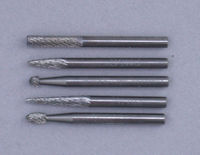
Burr (cutter)
Encyclopedia

Die grinder
A die grinder is a handheld power tool used to grind, sand, hone, polish, or machine material, typically metal but also plastic or wood. They are usually pneumatically driven, although versions with electric and flexible shaft drive also exist...
s, rotary tool
Rotary tool
A rotary tool is a hand held power tool with a variety of rotating accessory bits and attachments that can be used for cutting, carving, sanding, polishing and many other applications....
s or dentist's drills. The name may be considered appropriate when their small sized head (3 mm diameter shaft) is compared to that of a seed of the burr fruit
Burr (fruit)
A bur is a seed or dry fruit in which the seeds bear hooks or teeth which attach themselves to fur or clothing of passing animals or people. The hooks or teeth can be irritants and very hard to get off of clothing, such as wool or cotton...
or the teeth compared to a metal burr.
To maintain the correct surface speed and cutting conditions they are rotated at the highest speed possible, commensurate with their size and construction. The cutters shown in the image are made from tungsten carbide
Tungsten carbide
Tungsten carbide is an inorganic chemical compound containing equal parts of tungsten and carbon atoms. Colloquially, tungsten carbide is often simply called carbide. In its most basic form, it is a fine gray powder, but it can be pressed and formed into shapes for use in industrial machinery,...
which allows them to run at higher speeds than similar HSS
High speed steel
High speed steelMost copyeditors today would tend to choose to style the unit adjective high-speed with a hyphen, rendering the full term as high-speed steel, and this styling is not uncommon . However, it is true that in the metalworking industries the styling high speed steel is long-established...
cutters, yet still maintain their cutting edges.
Burrs (the tools) are also used in CNC machining centers for removing burrs (the small flakes of metal) after a machining process.
These tools usually spin at several thousand RPM. Because the cutting edges are so small, they can be touched when spinning by a finger without cutting the skin, which flexes out of the way, although it would not be safe to pinch or grip them from two sides. Hard metal or ceramic workpieces cannot flex beyond the cutting edges, so the tools remove material from them. This characteristic makes them suitable for dentistry, as the tool will grind the hard enamel of teeth, yet leaves soft mouth tissues unharmed if the tool should erroneously touch them.

